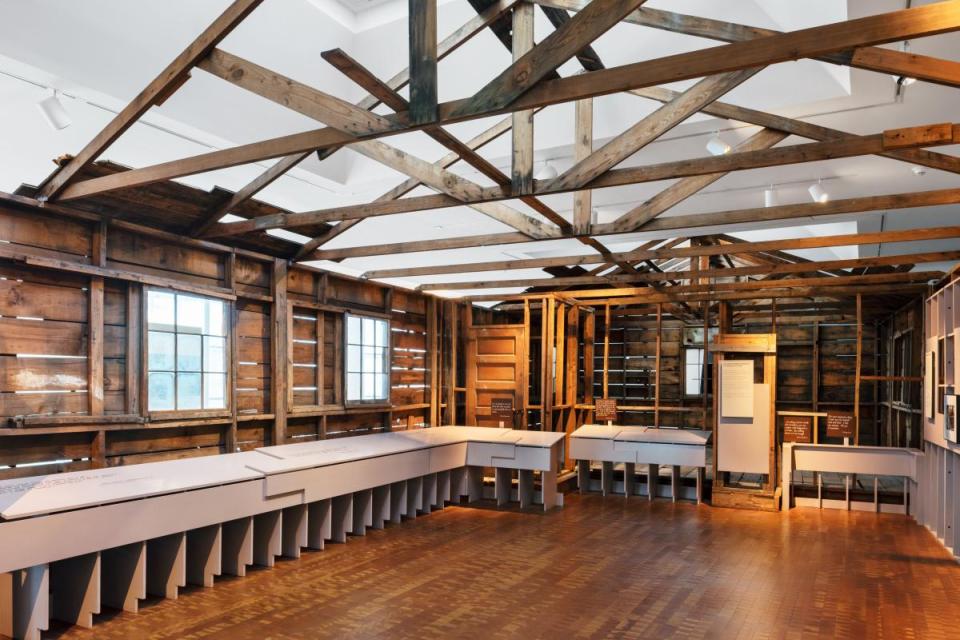即日発表 - 2005年05月15日
プレス連絡先:
Chris Komai - ckomai@janm.org - 213-830-5648

Japanese American National Museum’s History of Collaborations, Breakthroughs, Compiled Into New Book, “Common Ground”
The Japanese American National Museum, which was incorporated as an institution 20 years ago, has compiled a group of essays on its history, major projects and collaborations into a book, Common Ground: The Japanese American National Museum and the Culture of Collaborations.
In 1985, the National Museum had no permanent site nor endowment and only one employee. Thanks to a partnership between a group of Little Tokyo businessmen and a band of World War II veterans, the new National Museum was able to acquire key funding and access to the former Nishi Hongwanji Buddhist Temple as its original site. In the end, the National Museum raised over $57 million from 1985 to 1999, to renovate the former temple and to construct an 85,000-square-foot Pavilion in the process. The National Museum has grown into an internationally recognized institution, presenting award-winning exhibitions, groundbreaking traveling exhibits, educational public programs, innovative video documentaries and cutting-edge curriculum guides.
How a grassroots organization was able to do so much is discussed in various essays throughout the book. Common Ground devotes individual chapters on the National Museum's history and its philosophy on creating exhibitions and fundraising. Mostly authored by current and former staff and leadership, the essays range from the establishment of the institution's National Partnership Program, development of collaborative projects such as "Finding Family Stories" and the Boyle Heights Project, and even venturing outside of the United States for transnational partnerships.
In "Coming to Terms: America's Concentration Camps", Karen L. Ishizuka, who was the curator of America's Concentration Camps: Remembering the Japanese American Experience which opened in 1994, recalls the major controversy over terminology as the National Museum prepared to install a traveling exhibition on the unconstitutional incarceration of 120,000 Americans of Japanese ancestry in the Ellis Island Immigration Museum in 1998. Invited in 1995 to install America's Concentration Camps, Ishizuka and the National Museum were surprised to receive a facsimile in late January of 1998 that said in part, "The Park (Service) continues to strongly oppose the use of the words 'concentration camps' as a result of the most recent park exhibit and Smithsonian exhibit."
As Ishizuka explains in her essay, the National Museum had gone to great lengths to research and consult before using "concentration camp" in its exhibition in 1994. What was clear to Ishizuka was that the U.S. government had purposely used a series of euphemisms such as "evacuation", "relocation centers" and "non-aliens" to disguise the fact that they were violating the rights of American citizens. Government officials, behind the scenes, called the prisons "concentration camps."
The term "concentration camps" had become associated with the Holocaust and the National Parks Service said using the term would make an unfair comparison to the death camps. Faced with the possibility of cancellation, the National Museum consulted with its leadership, staff, volunteers and supporters as well as colleagues in the field. The majority urged the National Museum to stand firm.
Through the support of U.S. Senator Daniel Inouye and Norman Mineta (who both spoke to Secretary of the Interior Bruce Babbitt) and collaboration with the American Jewish Committee, the exhibition weathered a storm that was reported in the New York Times. But the experience showed that mission to tell the Japanese American story through an insider's perspective would not be easy.
Irene Hirano, President and CEO of the National Museum, writes about the connection to the Arab American community in the post-9/11 era. The parallels between 1941 and 2001 were clear. As with Japanese Americans after Pearl Harbor, Arab Americans were viewed by some with suspicion and hostility. Over 450,000 Arab Americans reside in Michigan alone and the Arab Community Center for Economic and Social Services (ACCESS) was in the process of creating an Arab American National Museum in Dearborn before September 11th. The National Museum had been sharing its experiences and expertise with ACCESS in support of their new museum.
After September 11, the National Museum sent a message to 60,000 of its supporters nationwide reaffirming its mission to "link the lessons of history to the present and a commitment to reach out to Arab Americans and Muslim communities who could be unfairly targeted." The institution organized public programs that discussed the issues of security and civil rights. In June 2002, the National Museum's Board of Trustees met in Dearborn "to express strong institutional support" for ACCESS. ACCESS Executive Director Ismael Ahmed recognized the importance to "open the museum, teach people bout who we are, and institutionalize our presence in this country so that we are seen as part of the whole, as Americans, not separate." The ties between Japanese Americans and Arab Americans grew as the similarities between both communities' museums became evident.
Edited by Akemi Kikumura-Yano, Lane Ryo Hirabayashi and James A. Hirabayashi, Common Ground touches on numerous projects in which collaboration brings about remarkable results and new ideas for museums everywhere. Published by the University Press of Colorado, it was made possible through the support of the Nippon Foundation. The book is available through the Museum Store at www.janmstore.com. For more information, call the Japanese American National Museum at (213) 625-0414.

